Coffee Trees Planting and Plant Spacing

This post is also available in:
This post is also available in:
![]() Français (French)
Français (French) ![]() العربية (Arabic)
العربية (Arabic) ![]() Português (Portuguese (Brazil))
Português (Portuguese (Brazil))
Before planting, you must research and learn basic details like your land’s soil and surface. A 45-degree slope is the recommended limit of inclination that terrain should have. If all the above requirements are met, but the slope’s angle is wider, you can still establish a plantation, but you should keep in mind that it will increase the difficulty of both manual and mechanical labor. Your land will be prone to faster erosion, and the organic materials and nutrients the plants require will wash easily during the rainy season.
To establish an appropriate planting density, it is crucial to consider the specific characteristics of the Coffea species and the variety in question, such as height and vegetative growth (some varieties have larger branches than others). Additionally, factors such as local temperature, microclimate, and soil type must be considered. Soils with a high sand content may not be able to support a high density of trees. Conversely, more fertile soils may allow for a higher planting density. However, if the soil exhibits signs of degradation, it is recommended to plant at a lower density to avoid competition for limited nutrient resources. To ensure optimal results, it is advisable to have soil samples analyzed by a laboratory prior to planting.
As I have mentioned in previous articles, most countries that produce this crop have national coffee associations, and farmers should always turn to them for advice. These institutions have observed for decades the behavior of the crop of interest, and they know the different types of soil that are found in the region they are based. As an example, I can mention ANACAFE in my home country Guatemala. Their studies have led them to recommend that farmers plant between 3,400 to 5000 trees per hectare (1380-2000 trees per acre) depending on the arabica variety; in the case of Robusta, they suggest planting between 625 to 1667 trees per hectare (253-675 trees per acre) [1]. Other countries like Colombia use similar densities but, in recent times, have modified their systems to go, in some cases, as high as 10,000 trees per hectare (4000 trees per acre)[2].
Moving forward, the number of trees that will go into your land will also depend on the chosen planting system:
- Rectangular & square system: trees are planted in straight rows. Four plants in two combined rows form either the shape of a rectangle or the shape of a square.
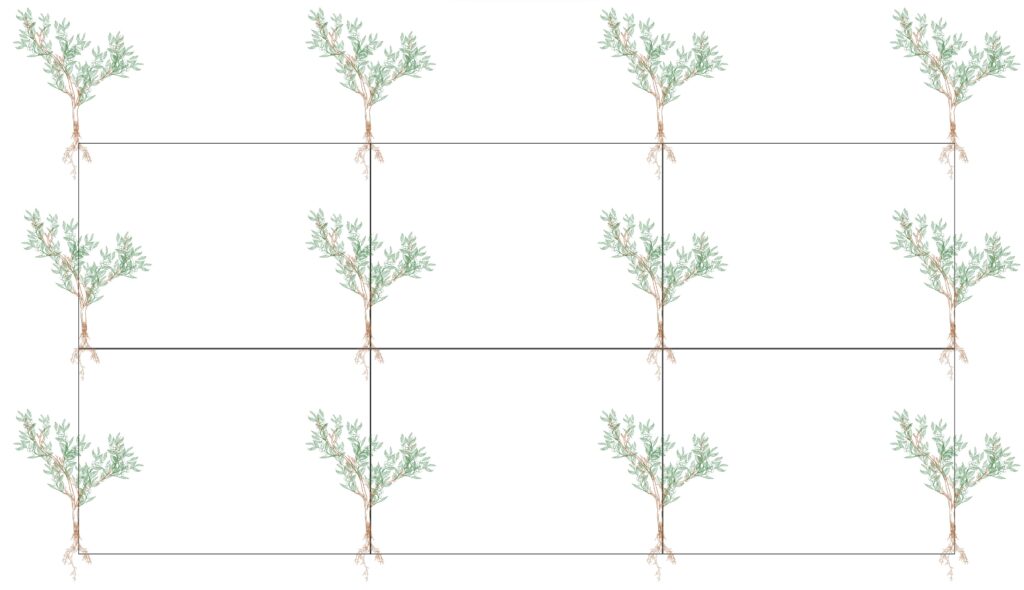
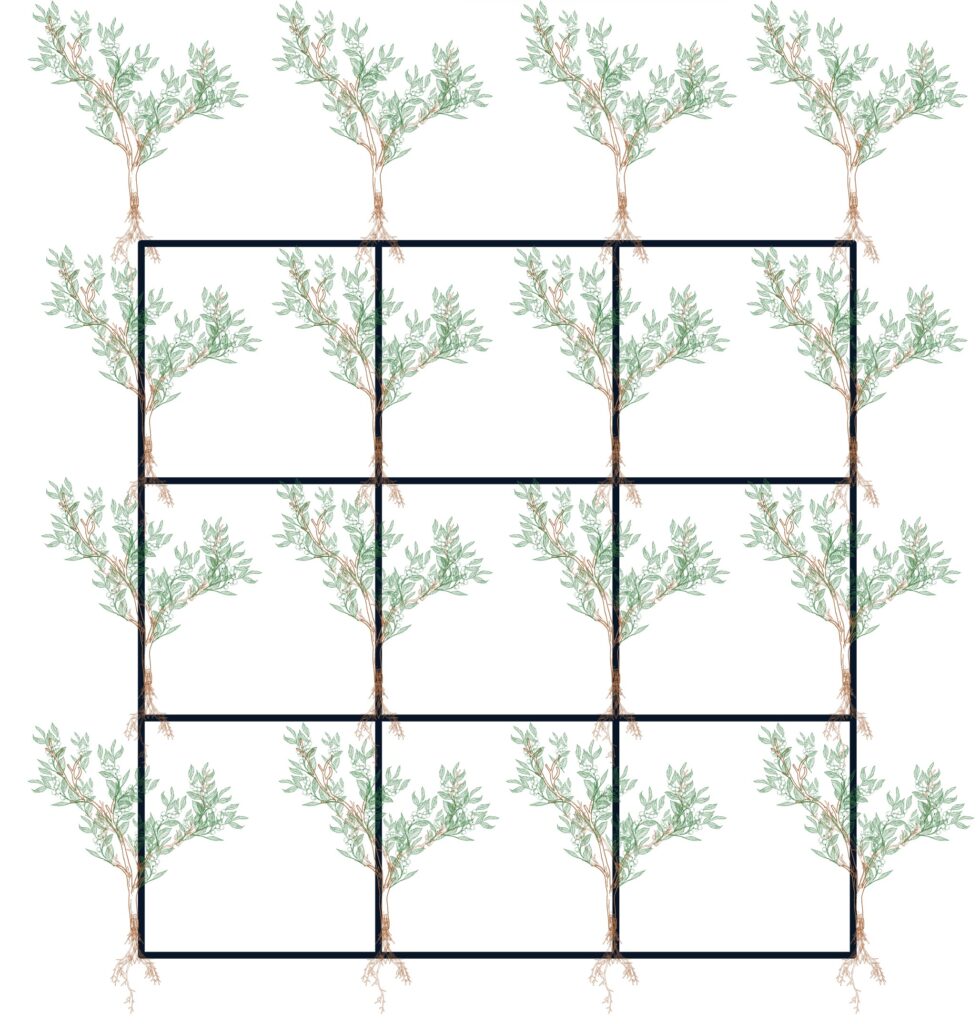
- Triangular System: Trees are also planted in straight rows. However, when you combine 3 plants in two rows, they form an equilateral triangle. This system’s only advantage is a more open space between trees. It is advisable to use it when your use intercrops.

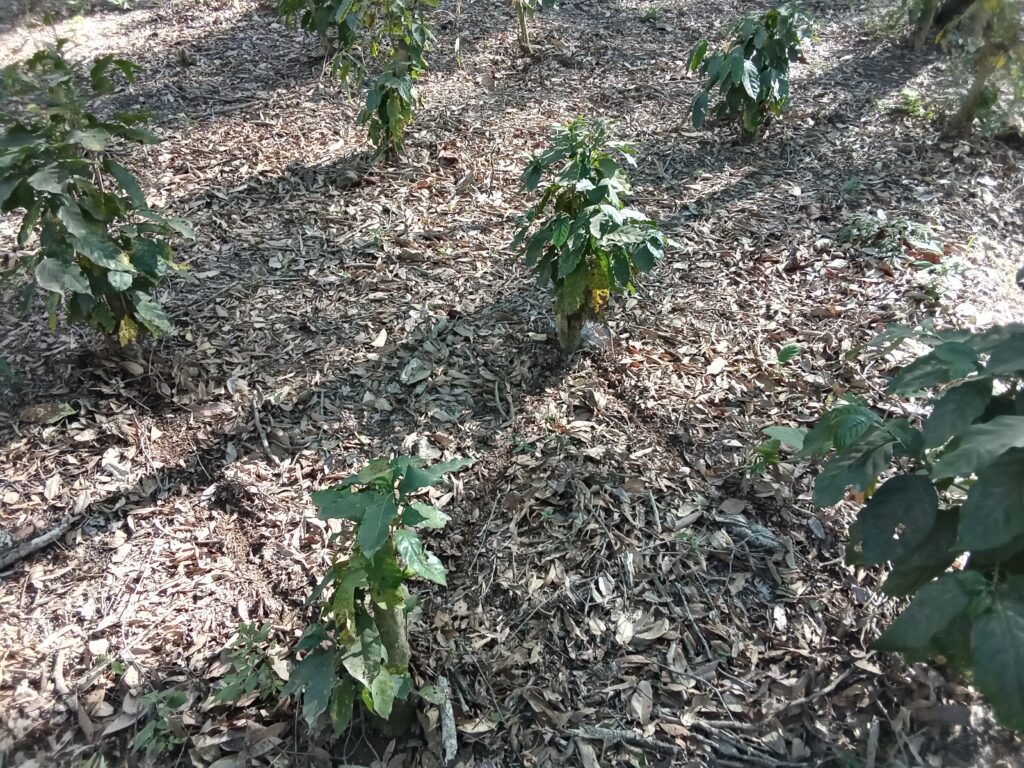
- Contour System: it serves best when planting on hills. In contrast to the previous method, the rows here are not straight, and they are adapted to the slope. As I mentioned early on, this terrain is prone to faster erosion. The purpose of this system is to serve as a barrier to water erosion. The curves of the furrow significantly decrease the speed of water streams caused by rain.
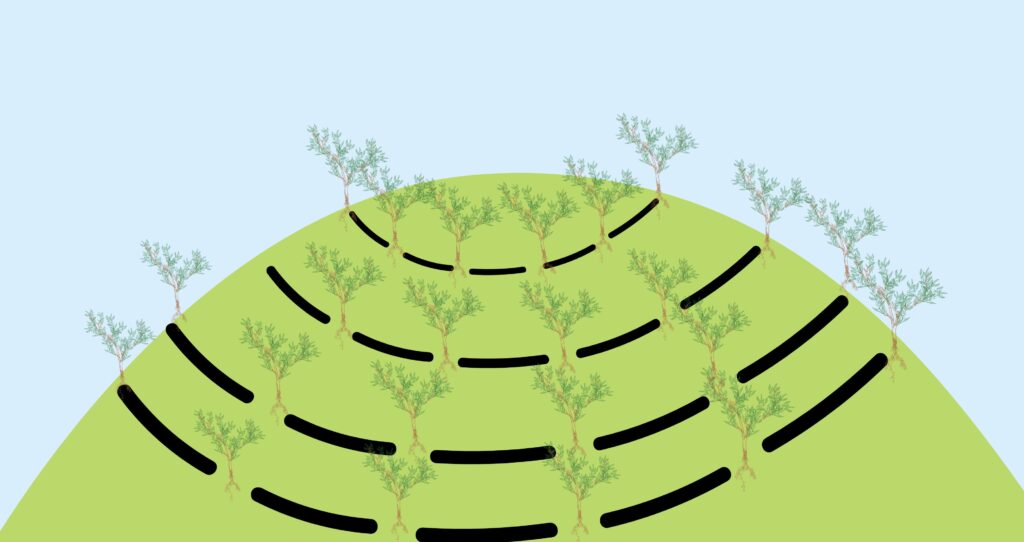
The spacing used for planting depends on the chosen system, but some of the most used measurements are as follows:

In contrast, Robusta trees are bigger, so the minimum distance between furrows and plants tends to be 2.50 m (8.2 feet).
Note that the planting distances given above serve as a guide and are by no means set in stone. Many factors come into play when planting coffee. I did not use those exact measurements for my plantation; I had to take into consideration that my coffee trees are not entirely exposed to the sun as I use an agroforest method that allows me to shade grow my crop. With less sunlight exposure, coffee trees produce fewer beans, so I had to compensate for that by inserting more trees in my land. So instead, I used spacings of 1.25 x 1.60 m (4.1 x 5.3 ft) and 1.25 x 2.00 m (4.1 x 6.6 ft), while one neighboring farm has gone as far as trying a 1 x 1 m (3.3 x 3.3 ft) spacing.
The lines and furrows of all the above systems can easily be plotted by using the line and string method. All you need to do is mark the planting area by using strings and pegs.
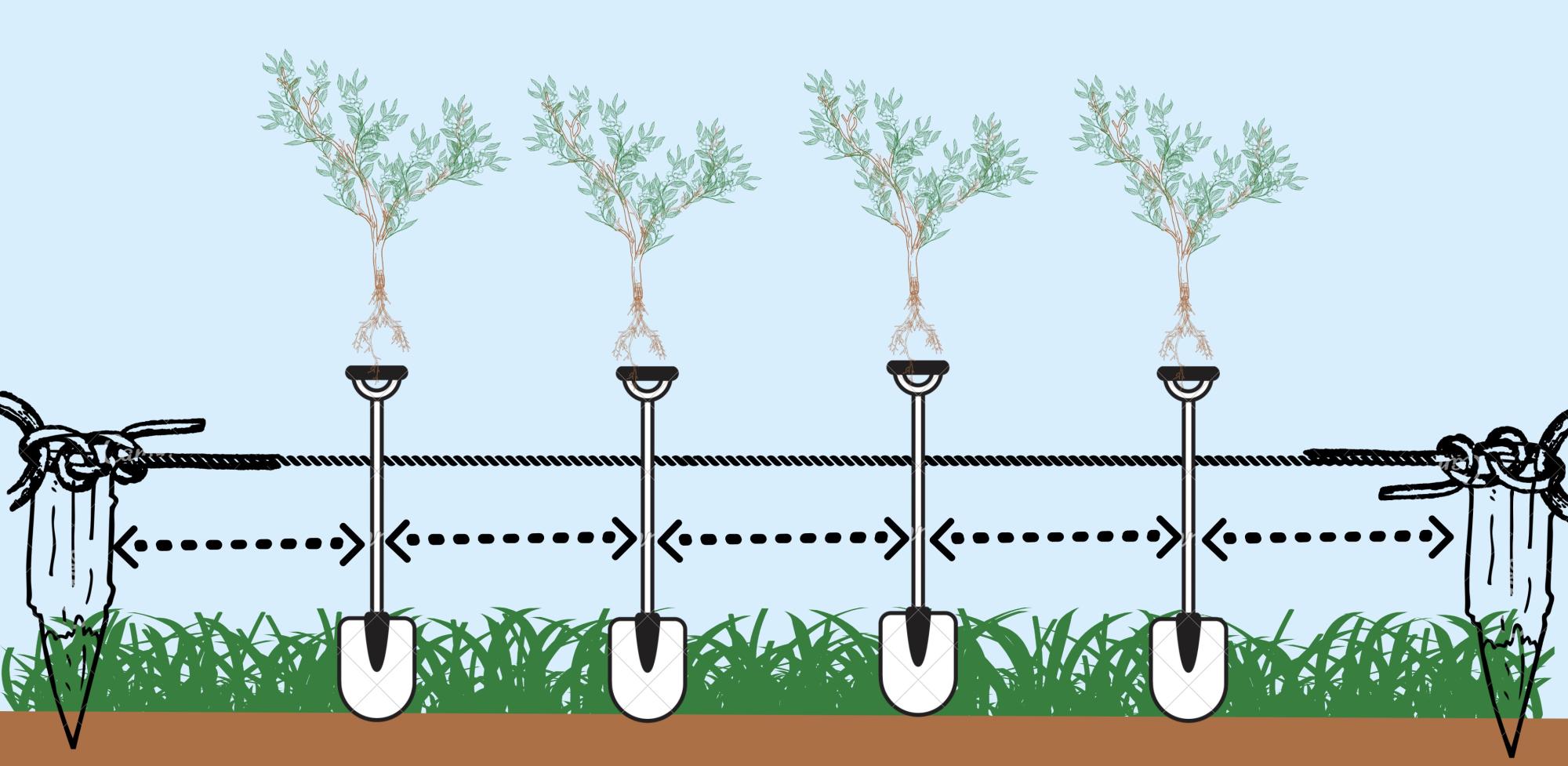
When planting your trees, you need to make sure to dig the holes in advance. That will save a lot of time. It may seem like an easy task but not doing it properly can lead to common and simple mistakes that will not allow your trees to survive once transplanted.
Hole requirements:
- Holes should be made keeping in mind the chosen distance between plants.
- Dig deep as 40 cm (1.3 ft).
- The mouth of the hole should have a 30 to 40-cm (1-1.3 ft) width.
- If the previously taken soil sample shows low fertility or if your substrate is sandy or muddy, then it is advisable to go as deep as 50 to 60 cm (1.6-2 ft). This way, you can add organic materials to the lowest layers of the hole before planting your tree.
- Make sure there are not any big rocks under the holes. If you find any, make sure to remove it, but if the rock is too big, then, following the line of the row, you should either move backward or forward and dig another hole even if that reduces the spacing between plants; you could also opt for not planting a tree in that spot. Keep in mind that coffee trees have a vertical root which is essential for their development and life. If this root finds an obstacle, it will not be able to keep growing down deep into the earth, and it will bend, eventually causing the tree to die.
Planting steps:
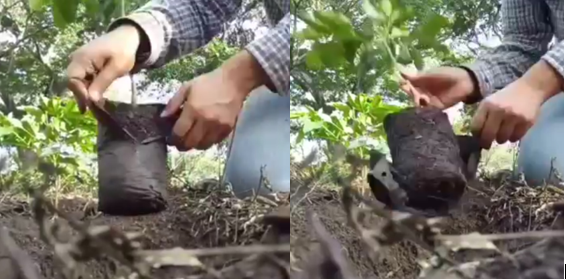
- Make sure you have a posthole digging bar with a tamper or a hand auger. Pick the hole some more to loosen the bottom of the hole. Once more, check that there are no big stones.
- Add some of the soil that was previously dug and, if required, some organic materials.
- Add a nematicide to the hole. This will eliminate any potential threat to the still-thin roots of the seedling.
- Use a knife to carefully cut the bag containing the seedling.
- Make sure the earth in the bag preserves its form without letting it crumble. That way, you will not damage its roots.
- Introduce the seedling in the middle of the hole and evenly fill it. Once finished, stomp the ground surrounding it to make it tight. The tree should be firm in the ground to prevent it from tilting and growing sideways.
Finally, it is essential to mention that constant monitoring will be required within the next couple of years. Many factors, like damaged trees during transportation or not taking the necessary precautions when planting, might cause some trees to die within their first 6 to 24 months. If this happens, you will need to plant new seedlings to replace the ones that did not make it.
References:
-Cultivo del café en Nariño, Cartilla divulgatoria, Lagos Burbano, Criollo Escobar, García Alzate, Muñoz Belalcazar, López Gómez, Benavides Arteaga, Dulce Delgado. P.26 Nariño University
https://sired.udenar.edu.co/6518/1/CARTILLA%20DIVULGATIVA%202020%20OK.pdf
-Manual Técnico para la Producción de Café Robusta, ANACAFÉ & USAID, P. 31, 2016. https://www.anacafe.org/uploads/file/283f6fd107ef4ce38af855880c47c49d/Manual-Cafe-Robusta.pdf
-Guía Técnica de Caficultura, ANCAFÉ 2018, P.76-89.
Densidad de siembra del café variedad castillo® en sistemas agroforestales, en el departamento de Santander-colombia by Fernando Valencia & Pedro María Sanchez Arcineagas. P. 57. Cenicafé. https://www.cenicafe.org/es/publications/3.Densidad_de_siembra_del_caf%C3%A9_Variedad_Castillo.pdf
Coffee plant History and general Information
Coffee Plant Information – Morphology
Coffee Genetics and Variety Selection
How to Select, and Treat Coffee Seeds
Germination of Coffee Seeds and Creation of Seedbeds for Planting
Coffee Trees Planting and Plant Spacing
How to Prune your Coffee Trees in an Agroforestry System
Shade-Grown Coffee in an Agroforestry System
Coffee Tree Flowering and Pollination
From Rainwater Harvesting to Irrigation of Coffee Trees
Coffee Tree Fertilization Requirements
Weed Management in a Coffee Plantation








































































